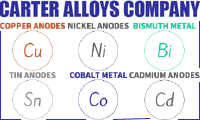
Curated with aloha by
Ted Mooney, P.E. RET

The authoritative public forum
for Metal Finishing 1989-2025

-----
Function of MSA and organic additives
2003
I have some questions in mind that I hope you'll find time to answer.. I am working in a semiconductor assembly at electroplating station.. we are on a Lead-Tin plating and some Lead-free plating(Pure Tin and Tin-Bismuth)
My questions are as follows... our plating bath contains Sn and Pb ions, MSA, anti-oxidant and some organic additives. I'd to know the reaction of MSA in aqueous plating solution(products of dissociation)? and the specific functions of organic additives? intermetallics are expected in Cu-Sn interface, what are the bonding associated with such discrete phase?
Thank you in advance,
- Muntinlupa, Manila, Philippines
Methanesulfonic acid (MSA)is a polar solvent from which metals can be electroplated. It is soluble in water and does not dissociate. the functions of the organic addition agents are for grain refinement, leveling and in some cases brightening the deposit. Bonding to a basis metal is the same as for other plating solutions from an acquous medium. That is some epitaxial growth in the crystal structure of the basis metal. If the metal is clean and free of oxides the bonding adhesion will be very good. (i.e. if pulled apart the break would be in the weakest metal and not at the interface.)

Don Baudrand
Consultant - Poulsbo, Washington
(Don is co-author of "Plating on Plastics" [on Amazon or AbeBooks affil links]
and "Plating ABS Plastics" [on Amazon or eBay or AbeBooks affil links])
2003
adv.: Supplier of Copper Anodes, Nickel Anodes, Bismuth Metal, & Other Metal Products for Industry & The Arts

Q, A, or Comment on THIS thread -or- Start a NEW Thread